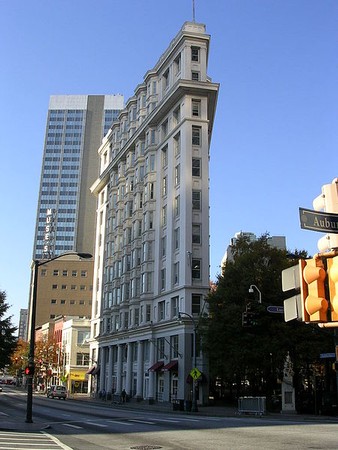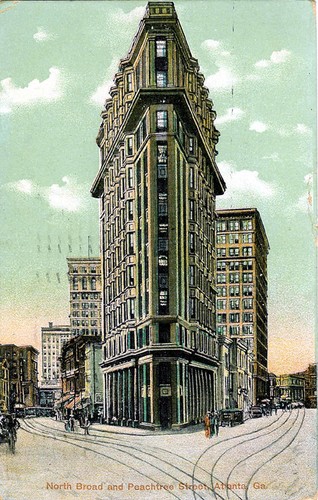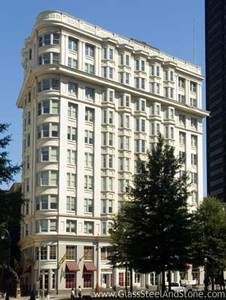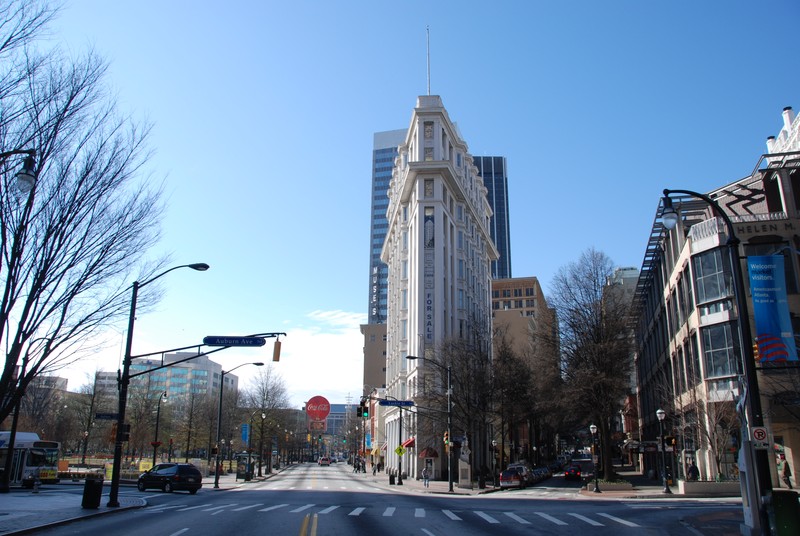The Flatiron Building (English-American Building)
Introduction
Text-to-speech Audio
Images
The Flatiron Building

A historic postcard of the Flatiron Building

The Flatiron Building

The Flatiron Building

Backstory and Context
Text-to-speech Audio
The English-American Building, also known as the Georgia Savings Bank Building and Flatiron Building, stood as Atlanta's second-ever skyscraper. The first skyscraper in the city was built by the Equitable Trust Company and was later demolished, leaving the English-American as the oldest remaining skyscraper in Atlanta. The English-American name comes from its original tenant, the English-American Loan & Trust Building, whose officers included Rufus B. Bullock, who once served as a Georgia governor during Reconstruction. The state forced him out in 1876 for trying to enforce political rights and protection for African Americans.
The English-American Loan and Trust Company built the skyscraper. Bradford Gilbert of New York City, a well-known and lauded nineteenth-century architect, designed the flatiron skyscraper in 1897. Eight years earlier, he designed New York City's first steel frame building, the Tower Building. By 1895, Gilbert maintained an office in Atlanta while acting as the supervising architect of the Cotton States and International Exposition. Also, while the New York City Flatiron building -- designed by the famed D.H. Burnham & Company, enjoys considerable notoriety, the English-American flatiron-designed skyscraper emerged nearly four years before its New York City counterpart.
Rufus B. Bullock served as president of the English-American Loan & Trust Company, which points to the second chapter of his life in Atlanta, one for which he enjoyed success in the private business sector. The first chapter for Bullock, a northern-born businessman who had cooperated with the Confederacy, involved his stint as a Republican Governor (1868 - 71) during the Reconstruction, one that ended with his removal after enjoying the reputation as the "most hated man in the state." He ostensibly attempted to provide African-Americans with an abundance of rights; the Ku Klux Klan led a movement to force him out of office. But, he did recover well and not only worked for the trust company but served as president of the Atlanta Chamber of Commerce and master of ceremonies at the Atlanta Cotton States and International Exposition in 1895.
The English-American Building name lasted until 1910 when the building became known as the Empire Life Building. The name changed again in 1916 when the structure was known as the Flatiron Building. In 1920, the Georgia Savings Bank and Trust Company purchased the building and remained its owner for nearly half of a decade, and then it changed hands again, which has been its ultimate story over time. Today, the building is known as Flatiron City and is the home to numerous businesses -- many of which are associated with technology. Thus, by looking at the history of Atlanta's flatiron building, one can view several chapters of the city's history, from Reconstruction to the 21st Century.
Sources
Duncan, Russell. "Rufus Bullock (1834-1907)." New Georgia Encyclopedia. georgiaencyclopedia.org. June 8, 2017. https://www.georgiaencyclopedia.org/articles/government-politics/rufus-bullock-1834-1907.
Etienne, Harley F and Barbara Faga, eds. Planning Atlanta. New York: Routledge, 2017.
Lyon, Elizabeth A. "Nomination Form: English-American Building (1897-1910), Flatiron Building and/or Georgia Savings Bank Building." National Register of Historic Places. nps.gov. March 26, 1976. https://npgallery.nps.gov/GetAsset/bf869059-2885-4fba-8b18-906de121b4d4
Smith, W. Calvin. "The Reconstruction "Triumph" of Rufus B. Bullock." The Georgia Historical Quarterly 52, no. 4 (1968): 414-25. Accessed March 9, 2020. www.jstor.org/stable/40578901.
https://www.history.com/topics/landmarks/flatiron-building
http://sites.rootsweb.com/~gafulto2/PhotoIndex.htm
http://www.city-data.com/forum/city-vs-city/777694-flatiron-building-atlanta-versus-nyc-5.html
https://atlantafinehomes.wordpress.com/2010/01/06/headline-atlantas-historic-flatiron-building-for-sale/
